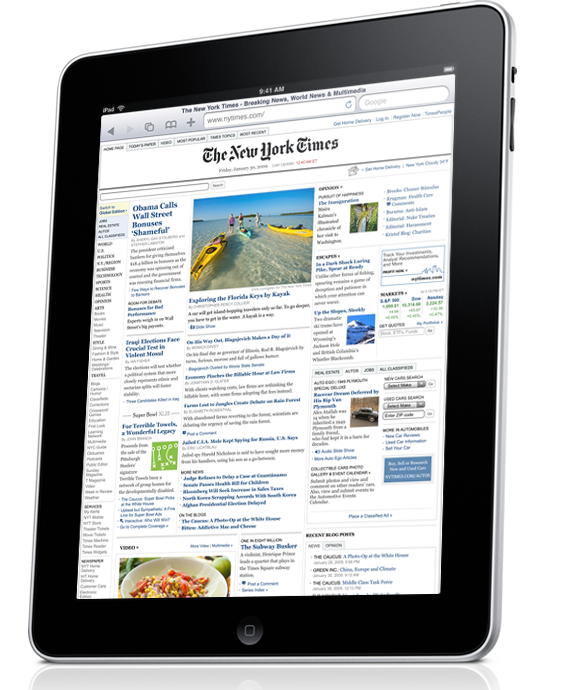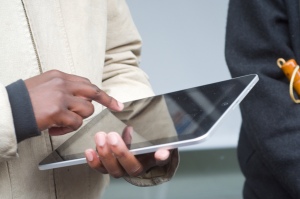The iPad Promises To Change Business and Mobile UC
 There is no doubt that the Apple iPad promises to change mobile computing for the consumer market. It’s more powerful than e-reader Kindle, yet smaller and thinner than a laptop and it’s shipping with thousands of apps easily and in many cases freely downloaded from the iPhone App Store. Being considered by some to be a large panel iPhone (viewing a web page is really hard on the iPhone because the screen real estate is so small), but with the same gesture features of the touch screen, the iPad will easily take up an obvious and familiar place in millions of iPhone users’ lives – particularly if a user can sync the iPad to the iPhone.
There is no doubt that the Apple iPad promises to change mobile computing for the consumer market. It’s more powerful than e-reader Kindle, yet smaller and thinner than a laptop and it’s shipping with thousands of apps easily and in many cases freely downloaded from the iPhone App Store. Being considered by some to be a large panel iPhone (viewing a web page is really hard on the iPhone because the screen real estate is so small), but with the same gesture features of the touch screen, the iPad will easily take up an obvious and familiar place in millions of iPhone users’ lives – particularly if a user can sync the iPad to the iPhone.
It will actually make reading a newspaper (shown in left) an easy and pleasant experience, instead of awkward on a laptop or painful on an iPhone. After all, newspapers are big and thin so readers don’t have to always flip the pages like they have to do with the tiny screens of modern smartphones. In a briefing I had with a client this morning the question came up, what makes this device class appropriate for enterprise markets and applications?
First of all, there aren’t too many jobs, roles or computing applications in business requiring users to read newspapers or e-newspapers. But, there are many applications in business, where users need to input data, users need to reference some file stored on a server, users need to edit web pages, users need to process email. Doing these tasks with a clipboard-sized tablet is easier and more convenient than doing so with a smartphone or a laptop. You can’t really use a laptop while standing. You can really use an iPad while standing.
Fictional History of Pad Computing
Since the iPad is really the first ‘pad computer’, with an OS optimized for flat screen – gestures, soft keyboard, and network input/output – it is however, quite a recognizable device, but from where? HP had been marketing a tablet computer since at least 2004, but this was a PC with Windows, a plug-in keyboard and a stylus as mouse. Not really a member of the category. Then it hit me that they used ‘pads’ on the Enterprise, on Star Trek, but the device was not a Gene Roddenberry invention. A quick search and the real history of the pad computer came to light. It was first presented in Isaac Asimov in Foundations (the original Foundations were published in short stories between 1942-1950), Arthur C. Clarke in 2001: A Space Odyssey which was first published in 1948.
 So, in these fictional depictions, the pad computer is used to read books and newspapers and from my recollection of Star Trek, the pads are used to digitally compose and sign status reports, ship logs, entries on patient charts and input personal log entries. All of which are doable with the iPad.
So, in these fictional depictions, the pad computer is used to read books and newspapers and from my recollection of Star Trek, the pads are used to digitally compose and sign status reports, ship logs, entries on patient charts and input personal log entries. All of which are doable with the iPad.
In fact, Apple has created a business-centric offshoot of the iPad website where it presents the business-oriented feature set of the iPad, application scenarios and security information. The mail client is easily configured for integration with Microsoft Exchange server, open standard calendar and email services to get email and calendar information. The iPad also boasts a VGA interface so you can broadcast the Keynote, Pages or Numbers presentation (Keynote is a PowerPoint equivalent, Pages is the Word equivalent and Numbers is the XL equivalent) you created on the iPad. Safari browser, VPN access clients and the corporate configuration utility lets mobility managers establish and enforce standards for broad user adoption of the platform.
More interesting is the range of optional accessories including the earphones with remote and microphone also suitable for use with iPhones and later generation iPods. The iPad also incorporates bluetooth support, an accelerometer (motion/landscape/portrait detection), GPS and digital compass for location-based applications. So, as you would expect the iPad can support mobile VoIP software. Some leading vendors have already announced their iPad client; we should expect more to enable this app. With the soon-to-be-released OS 4.0 where apps can run concurrently in the background, the iPad will be a great Instant Messaging, directory and presence endpoint.
No doubt business people will use these devices to control their appointment calendar, read or edit reports, browse and manage their emails while standing or sitting. For those that don’t like soft keyboards on the panel, the Apple wireless (bluetooth) keyboard can work, and a stand is available for docking in a more formal posture.
But, what we really expect to happen is that the enterprising enterprise software development team will develop custom apps that make the iPad an integral element of the enterprise infrastructure. It will be adapted for doctors to call up the patient’s latest charts and results. It will be adapted for supervisors to record their observations. It will be adapted for researchers to quickly record their references. It will be adapted for all manner of professional application. Mobile UC will be a natural extension of the devices’ capabilities.

